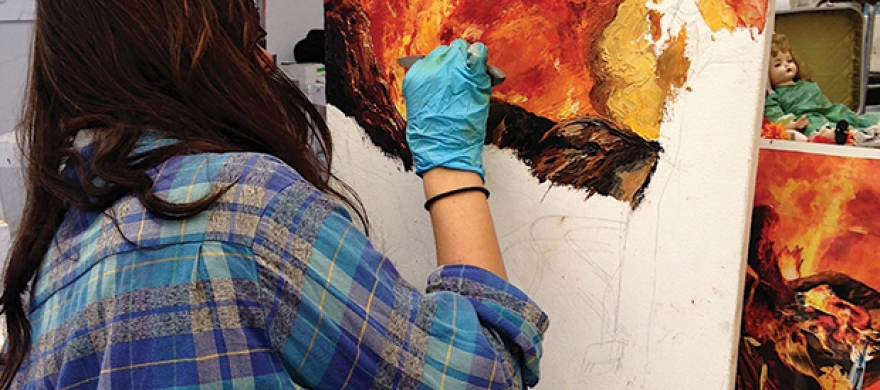A Word of Art
They say a picture is worth a thousand words, but each year Great Books and fine arts students team up to find out how many words it takes to paint a picture.
In the Divine Comedy, Italian poet Dante Alighieri unlocks the reader’s imagination with detailed descriptions of pain, warfare, deception, and punishment, drawing on medieval Christian theology and philosophy. Similarly, John Milton’s Paradise Lost explores supernatural themes through tales of creation, the fall of man, and redemption.
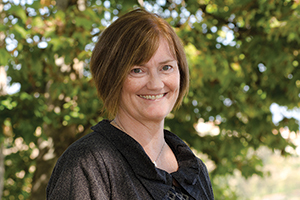 Jane Kelley Rodeheffer
Jane Kelley Rodeheffer
In professor Jane Kelley Rodeheffer’s Great Books Colloquium seminar, students follow
Dante’s journey through hell, purgatory, and heaven, and get a glimpse of how Milton
justifies the will of God through the 12 books of his epic poem. In a rare collaboration
between the Great Books and fine arts departments, Rodeheffer invites her students
to explore how poets like Dante and Milton summon images through words.
“These poems are intended to engage the reader’s visual imagination,” she explains.
“They have been represented by artists for centuries, including Blake, Botticelli,
Doré, and Dalì, and naturally lend themselves to illustration,” points out the Fletcher
Jones Chair of Great Books, whose students receive a unique opportunity to bring their
readings to life.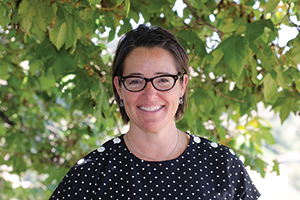 Gretchen Batcheller
Gretchen Batcheller
First launched in 2014, Rodeheffer approached associate art professor Gretchen Batcheller
about a collaboration that would enable both of their students to grow as communicators,
as well as professionals. Rodeheffer’s Great Books students would choose cantos from
the Inferno and write a description of the tale’s settings, and Batcheller’s painting students
would work with them to illustrate the words using multiple mediums.
“My students are participating not only in a tradition of reading these texts and
interpreting them—which they do in papers—but also interpreting them visually,” says
Rodeheffer. “I want them to see that the tradition they’re learning is multifaceted.
It’s not just words on a page.”
Students received another opportunity in 2015, when they collaborated to visually
depict scenes from Milton’s Paradise Lost. In order for this collaboration to work effectively, both sets of students met once
a week over the course of a month to further discuss their vision for the painting.
For history major Katherine Anderson, this experience taught her that while everyone
read the same brief descriptions of a selected scene, they all nnmagined the designs
differently in their minds.
“I wrote what I envisioned the painting to look like, but the artist did not necessarily
go by what I wrote. It was interesting to see how she made connections and interpreted
things differently,” she says.
With a ratio of one artist to five Great Books students, the artists sometimes felt
overwhelmed in sufficiently and accurately meeting the group’s expectations. This
is where Batcheller stepped in to teach the young painters how to form healthy professional
boundaries when commissioned by clients to create art.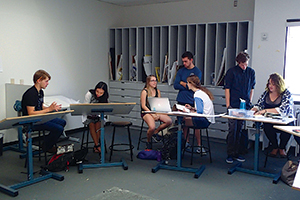 Great Books and art students discuss their collaborative visions.
Great Books and art students discuss their collaborative visions.
“I encouraged my students to not suddenly become different art makers than they had
already been in the context of the class,” she shares. “Yes, try new techniques, but
don’t all of a sudden become this type of art-maker when you were always that kind
of art-maker, just to suit the many requests from the group.”
She also gave her students permission to be uniquely themselves, and to push forward
with what they felt was most important as far as conveying each specific scene with
visual imagery. “Navigating those interpersonal skills was huge. That’s something
that we navigate in the workplace on a daily basis, so that was pretty important,”
Batcheller says.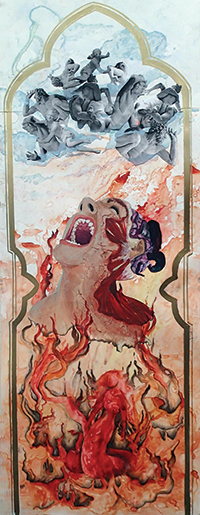 Sarah Lindsley
Sarah Lindsley
Divining Milton: Satan Gives Birth to Sin Paradise Lost II: 635-808
These techniques impressed Great Books student Kylie Owens, who was so astounded by
the artist’s painting that she felt compelled to revisit Paradise Lost.
“Sometimes with texts like that, it’s difficult to visualize things,” the theatre
major admits. “It goes to show how the classics cross all borders with all disciplines
and all studies—everyone can relate to them in some way,” she says.
Such has certainly been the case for Great Books student Callaghan McDonough, who
remembers the experience as intellectually challenging. “It was definitely more of
an emotional investment than the typical essay, because we had to analyze the visceral
impact the scene had on us, and then communicate how that scene might be visually
represented, in order that it might have the same effect on the viewer as the author's
words initially had on us,” he explains.
Once the Great Books students and artists agreed on the final presentation of the
paintings, Batcheller organized a pop-up exhibition in Payson library. She then photographed
the artworks and Rodeheffer submitted them for publication in the third volume of
the undergraduate Great Books journal Athena’s Gate.
Rodeheffer believes that this collaborative project represents an appropriate and
timely direction that humanities courses should consider.
As she explains, “We need to move in the direction of collaborating with disciplines
in the arts and sciences and showing the ways in which literature, history, and philosophy
remain vital to this generation of students.”
